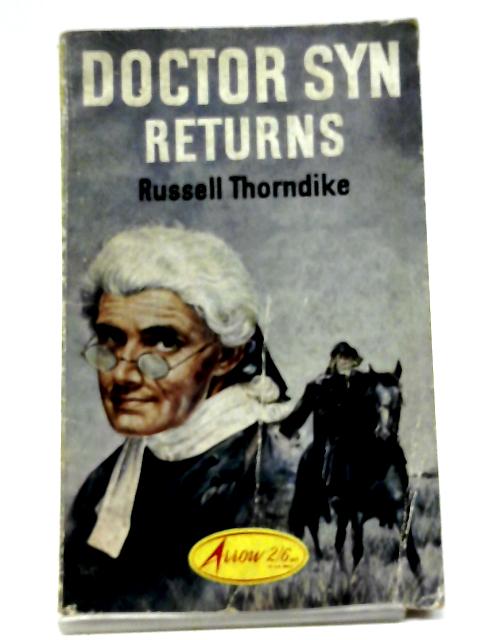***
Who is Doctor Syn? That's perhaps the question of the work itself. The first book Doctor Syn: A Tale of the Romney Marsh, was published in 1915 by Russell Thorndike. Several others were written in the 1930s, and show the difference in content and themes. Here's the Wikipedia entry; here's a link to the Wikisource text of the first book.
Anyway, having given you a chance to encounter the work on your own terms, I'm going to offer my account of the stories. They are set in the late eighteenth century on the south coast of England in the village of Dymchurch on the Romney Marsh. This is the parish of Dr Syn - country vicar, old friend of the squire, Doctor of Divinity and a pillar of the quiet rural community. However, smuggling is afoot, led by the mysterious figure known only as the Scarecrow and his diabolically-costumed gang, the Night Riders - who are pursued both by customs agents and the Royal Navy.
Of course, anyone with a name like Dr Syn is never going to be entirely what they seem. And given my invocation of Robin Hood earlier, you may have guessed by now that Dr Syn is the Scarecrow. Syn's past is not what it seems; a brilliant scholar at Oxford and a keen duellist, he seemed willing to settle down to the life of a village priest - until his Spanish bride ran off with another man. He pursued them to America, but was captured by pirates and in his quest for revenge turned to piracy himself, eventually earning infamy as the notorious Captain Clegg. Along the way he met Mr. Mipps, his mate and later sexton of Dymchurch. At last, wearying of piracy he sank his own ship and returned to England (where Dr Syn Returns picks up). Mipps in time joins him. Even as Syn looks to conceal his past, he longs to demonstrate his own prowess - and wishes to protect the smugglers that make up his parish from the harshness of the law. Thus, he takes up the guise of the Scarecrow.
What makes these books notable? Well, 18th century smuggling yarns are nothing new, but these are well-executed and atmospheric. Dymchurch is a small place - this is no kind of epic - but the sense of place is quite strong. (The relative smallness of the place and stakes - a very human scale - perhaps contributes to its success). To my mind though, Dr Syn is the most compelling feature of these books. Unlike Robin Hood, Zorro or Batman he is given a certain genuine unpleasantness. Firstly, he seems to enjoy the sport and power of smuggling - despite mastery of the smugglers of the marsh, he never quite manages to divert them from smuggling altogether. It is never an entirely heroic endeavour.
Secondly, he is willing to kill in defence of his hidden identity - and not merely in combat (quite unlike Bruce Wayne, say). His position as parish priest, as well as his friendship with the squire and his ill-gotten gains him a great deal of sway over the village - which probably says something for the legal status of the Church of England at the time. (The elaborate codes of 18th century dress and manners are useful in making the hidden identity element seem a little more realistic; Dr Syn shaves off the locks of hair he wore as Clegg and dons a horsehair wig). Adding to this sinister aspect, the books are often have chapters written from the position of someone other than Syn, where his power, if never altogether malevolent, does seem overwhelming. His past as a pirate is rarely glossed over either; his eventual nemesis is a man whose tongue he cut out and he marooned.
 |
| Dr Syn Returns, Published by Arrow Books, 1959 |
Thirdly, when he plays the villainous Scarecrow, he puts all his powers to it. Even if he is not (always) as such a killer, the use of demonic images and manners is dramatic - especially coming from a Priest! The elderly woman who keeps a hidden stable for his great black horse, Gehenna, frankly believes him to be the Devil. Now, she was subject to delusions about being a witch before this, so our protagonist is trading on an old woman's madness for his convenience. It's an unsettling scene - the urbane Dr Syn actually saying 'Yes, I'm the Devil' and hamming it up properly. Whatever Batman's vampire-esque affect, it never quite reaches that extent.
All this makes Dr Syn a troubling character - more so, I think than his counterparts detailed above. The tone of Thorndike's stories varies: sometimes it is all pure pluck and valour and not a corpse in sight. But all the same, the eerie quality of the Scarecrow and the darkness of the marshes persists.
I haven't been too keen on seeking out adaptations, though Dr Syn has been put to film a few times. A television series was made by Disney, starring Patrick McGoohan (of The Prisoner fame) and filmed in Romney; from what I've seen of it this isn't quite dark enough for my tastes (possibly a quality of the technology of the time) and makes Syn into slightly too heroic a figure - with occasional references to George III's tyranny for the American audience. There's a little too much of the Western in it for my liking. Hammer Horror also did a somewhat reworked version with Peter Cushing as 'Parson Blyss'. To my mind though, the adaptation most worth looking for is the one narrated by Rufus Sewell for BBC Radio. The pictures are better.
Dymchurch, also notable as the terminus of a half-scale steam railway -- surely a likely target for the Ant Hill Mob's Tiny Train Robbery.
ReplyDeleteNot a combination I had considered....
Delete